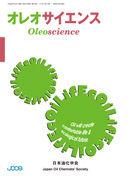
- |<
- <
- 1
- >
- >|
-
Ryotaro MIKI2019Volume 19Issue 1 Pages 5-11
Published: 2019
Released on J-STAGE: September 25, 2019
JOURNAL FREE ACCESSWe prepared a novel glucose-responsive gel formed by worm-like micelles (WLMs), which has the potential to provide a self-regulating insulin delivery system. We used 75 mM cetyltrimethyl-ammonium bromide, 75 mM phenylboronic acid, and water to prepare the gel. At pH 9.4, the system was highly viscous and supported its own weight, and dynamic viscoelasticity measurement indicated that it contained long and entangled WLMs. The visual observation revealed that the gel with 10 mM glucose changed to sol-like appearance, whereas those prepared to include a control compound (10 mM diethylene glycol) retained their gel-like appearance. In vitro release was evaluated using a test compound (fluorescein isothiocyanate dextran) in a microsized flow system. By 120 min, the release of this compound from the WLM gel was around 27-fold greater in the presence of 100 mM glucose than with 100 mM diethylene glycol. This demonstrated the successful preparation of a WLM gel that showed an altered drug release rate, depending on glucose.
View full abstractDownload PDF (1213K)
-
Takaya SAKAI2019Volume 19Issue 1 Pages 13-20
Published: 2019
Released on J-STAGE: September 25, 2019
JOURNAL FREE ACCESSUnilamelar vesicles in water spontaneously adsorb onto solid surfaces, sometimes rupturing and fusing to form a supported bilayer film. Although the general understanding of this process of interest and the driving force has been discussed, it has not been clarified due to the technical difficul ty. Recently, we succeeded to observe the dynamic bilayer formation behavior of dioctadecyldimethyl ammonium bromide (DODAB) vesicles, whose gel-liquid crystal transition temperature (Tc ) is 44°C, at the mica–water interface by high-speed atomic force microscopy (AFM) at 25°C. The vesicles instantaneously changed into the bilayer domains on solid surface and they rarely fused each other. Finally, the homogeneous bilayer film was not formed on mica surface. Another cationic surfactant (D18EAC) vesicle, which has the higher Tc, formed the tetralayer domain on mica surface on the way to bilayer transition. The much higher aggregation ability between the hydrophobic alkyl chains of D18EAC might make the motion of molecules slow. Therefore, it was clarified that the states of hydrated solid unilamellar shell of vesicles should affect the dynamic process of solid-supported bilayer formation.
View full abstractDownload PDF (1889K)
- |<
- <
- 1
- >
- >|